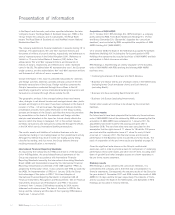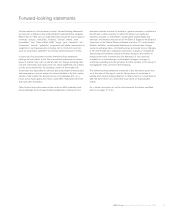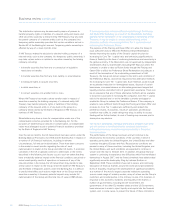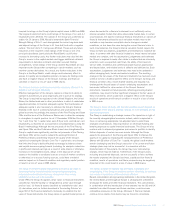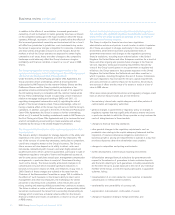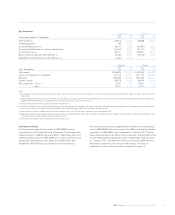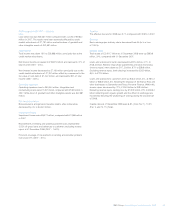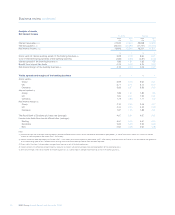RBS 2008 Annual Report Download - page 31
Download and view the complete annual report
Please find page 31 of the 2008 RBS annual report below. You can navigate through the pages in the report by either clicking on the pages listed below, or by using the keyword search tool below to find specific information within the annual report.
RBS Group Annual Report and Accounts 200830
Business review continued
borrowers and counterparties, with increasing delinquencies, defaults
and insolvencies across a range of sectors. This trend has led and may
lead to further impairment charges, higher costs, additional write downs
and losses for the Group or result in a loss of value in RBS shares.
The actual or perceived failure or worsening credit of the Group’s
counterparties could adversely affect the Group.
The Group’s ability to engage in routine funding transactions has been
and will continue to be adversely affected by the actual or perceived
failure or worsening credit of its counterparties, including other financial
institutions and corporate borrowers. The Group has exposure to many
different industries and counterparties and routinely executes transactions
with counterparties in the financial industry, including brokers and
dealers, commercial banks, investment banks, mutual and hedge funds
and other institutional clients. As a result, defaults by, or even the
perceived creditworthiness of or concerns about, one or more corporate
borrowers, financial services institutions, or the financial services industry
generally, have led to market-wide liquidity problems and could lead to
losses or defaults by the Group or by other institutions. Many of these
transactions expose the Group to credit risk in the event of default of the
Group’s counterparty or client. In addition, the Group’s credit risk is
exacerbated when the collateral it holds cannot be realised or is
liquidated at prices not sufficient to recover the full amount of the loan or
derivative exposure that is due to the Group, which is most likely to occur
during periods of illiquidity and depressed asset valuations, such as
those currently experienced. Any such losses could have a material
adverse effect on the Group’s results of operations and financial condition
or result in a loss of value in RBS shares.
The Group’s earnings and financial condition have been, and its future
earnings and financial condition are likely to continue to be, affected
by depressed asset valuations resulting from poor market conditions.
Financial markets are currently subject to significant stress conditions,
where steep falls in perceived or actual asset values have been
accompanied by a severe reduction in market liquidity, as exemplified by
recent events affecting asset backed collateralised debt obligations
(CDOs), the US sub-prime residential mortgage market and the
leveraged loan market. In dislocated markets, hedging and other risk
management strategies have proven not to be as effective as they are in
normal market conditions due in part to the decreasing credit quality of
hedge counterparties, including monoline and other insurance
companies and credit derivative product companies. Severe market
events have resulted in the Group recording large write-downs on its
credit market exposures in 2007 and 2008. The Group expects that the
deterioration in economic and financial market conditions will lead to
further impairment charges and write-downs during the current financial
year. Moreover, recent market volatility and illiquidity has made it difficult
to value certain of the Group’s exposures. Valuations in future periods,
reflecting, among other things, then-prevailing market conditions and
changes in the credit ratings of certain of the Group’s assets, may result
in significant changes in the fair values of the Group’s exposures, even in
respect of exposures, such as credit market exposures, for which the
Group has previously recorded write-downs. In addition, the value ultimately
realised by the Group may be materially different from the current or
estimated fair value. Any of these factors could require the Group to
recognise further significant write-downs or realise increased impairment
charges, any of which may adversely affect its financial condition and
results of operations or result in a loss of value in RBS shares.
The value or effectiveness of any credit protection that the Group
has purchased from monoline and other insurers and other market
counterparties (including credit derivative product companies) depends
on the value of the underlying assets and the financial condition of the
insurers and such counterparties.
The Group has credit exposure arising from over-the-counter derivative
contracts, mainly credit default swaps (CDSs), which are carried at fair
value. The fair value of these CDSs, as well as the Group’s exposure to
the risk of default by the underlying counterparties, depends on the
valuation and the perceived credit risk of the instrument against which
protection has been bought. Since 2007, monoline and other insurers
and other market counterparties (including credit derivative product
companies) have been adversely affected by their exposure to
residential mortgage linked and corporate credit products. As a result,
their actual and perceived creditworthiness deteriorated significantly in
2008 and may continue to be so impacted in 2009. If the financial
condition of these counterparties or their actual and perceived
creditworthiness deteriorates further, the Group may record further
credit valuation adjustments on the CDSs bought from these
counterparties in addition to those already recorded.
Changes in interest rates, foreign exchange rates, bond, equity and
commodity prices, and other market factors have significantly affected
and will continue to affect the Group’s business.
Some of the most significant market risks the Group faces are interest
rate, foreign exchange, bond, equity and commodity price risks.
Changes in interest rate levels, yield curves and spreads may affect the
interest rate margin realised between lending and borrowing costs, the
effect of which may be heightened during periods of liquidity stress,
such as those experienced in recent months. Changes in currency
rates, particularly in the sterling-US dollar and sterling-euro exchange
rates, affect the value of assets, liabilities, income and expenses
denominated in foreign currencies and the reported earnings of the
Group’s non-UK subsidiaries (principally ABN AMRO, Citizens and RBS
Greenwich Capital) and may affect income from foreign exchange
dealing. The performance of financial markets may affect bond, equity
and commodity prices and, therefore, cause changes in the value of the
Group’s investment and trading portfolios. This has been the case
during the period since August 2007, with market disruptions and
volatility resulting in significant reductions in the value of such portfolios.
While the Group has implemented risk management methods to mitigate
and control these and other market risks to which it is exposed, it is
difficult, particularly in the current environment, to predict with accuracy
changes in economic or market conditions and to anticipate the effects
that such changes could have on the Group’s financial performance and
business operations or result in a loss of value in RBS shares.
The Group’s borrowing costs and its access to the debt capital
markets depend significantly on its credit ratings.
On 19 January 2009, Fitch cut the Group’s individual rating to E from
B/C and downgraded the Group’s Tier 1 preference shares to BB- from
A+ and upper tier 2 hybrid capital instruments to BB from A+. The long-
term credit rating for senior unsecured debt of AA- and short term
rating of F1+ were affirmed. On the same date, Standard & Poor’s






